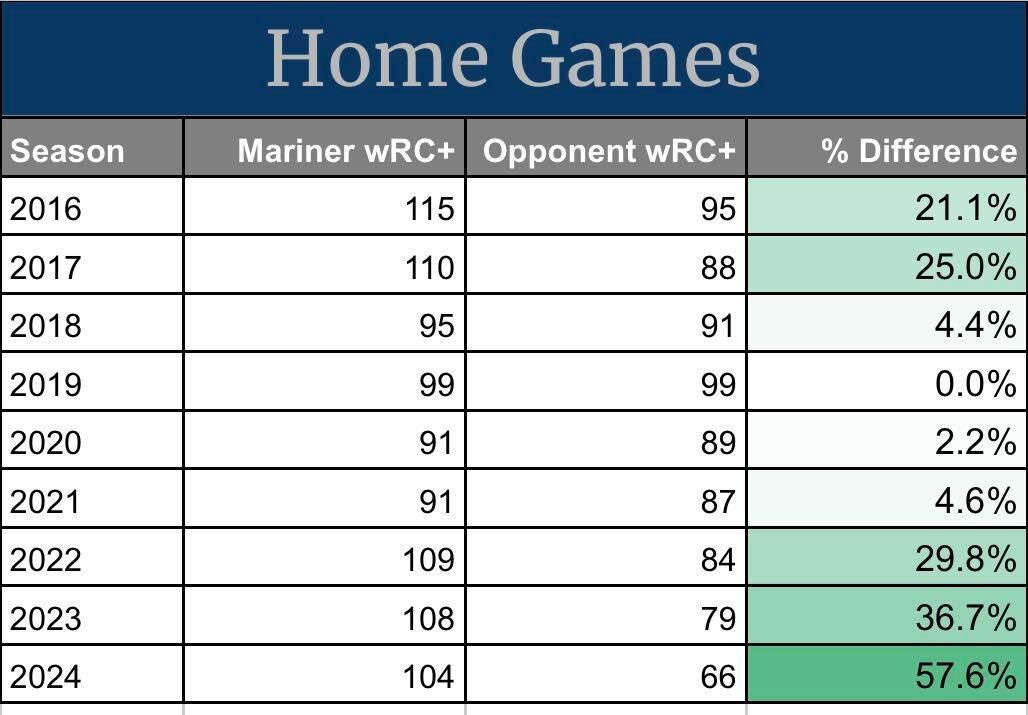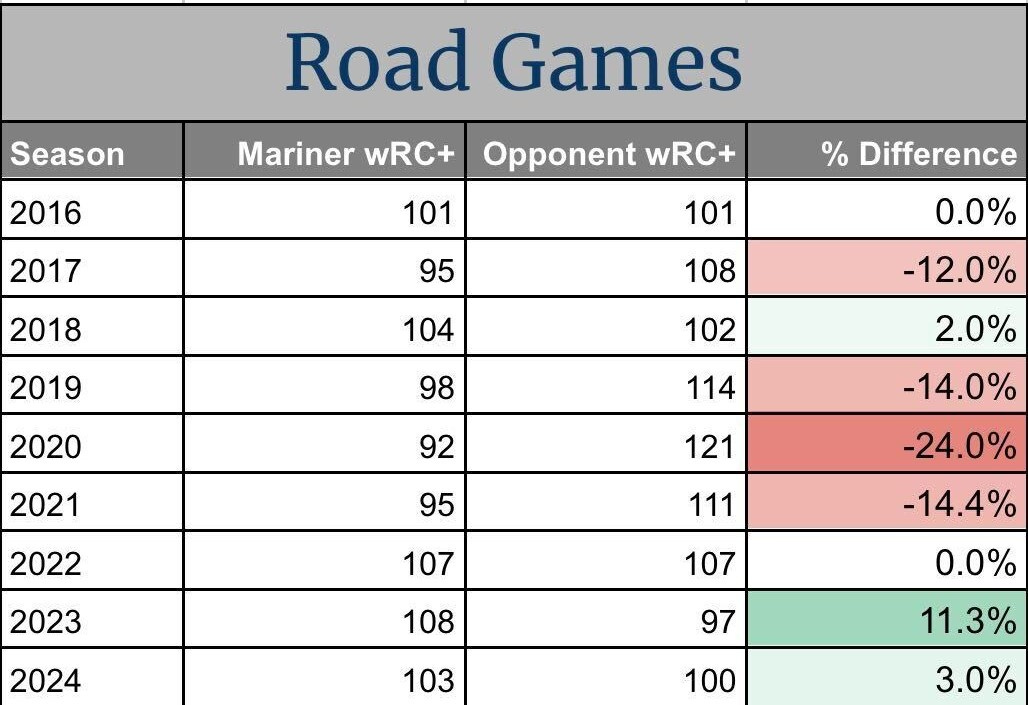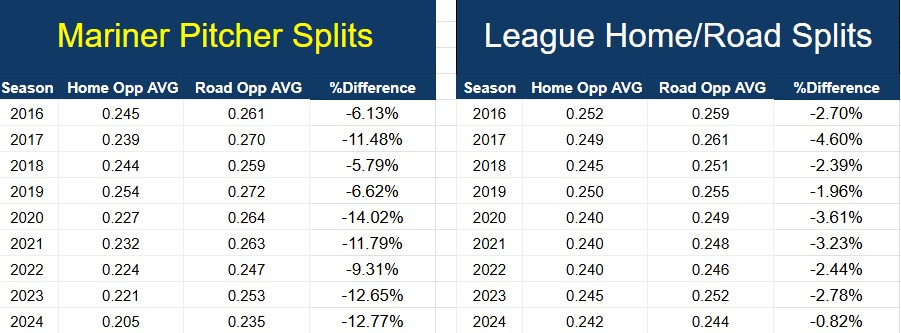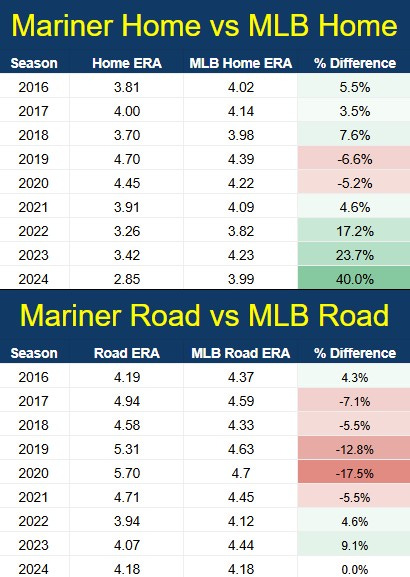The Numbers Hut: T-Mobile Park is Good, Actually
I come to praise the Seattle Mariners in earnesty and truth
Welcome to The Numbers Hut. This is going to be a recurring feature of the newsletter, although transparently an infrequent one. I am by no means an analyst of any kind. While I’ve been reading and, to varying degrees, appreciating and understanding the use of analytics in baseball for 25 years or so I would never pretend to be particularly adept at their usage. All the data herein was helpfully collated and synthesized into digestible images by my friend and colleague, Samuel Joseph.
INTRODUCTION
T-Mobile Park is a pitcher’s ballpark. There is nothing revolutionary or insightful about that observation. Players and analytics have been noting the run-suppressive environment of the Mariners’ home park since it opened in 1999. For anyone somehow new to the idea, here’s the history of T-Mobile’s Park Factor on Baseball Savant, using three-year rolling averages:
2001: 25th (of 25)
2002: 28th (of 28)
2003: 28th (of 29)
2004: 26th (of 27)
2005: 26th (of 28)
2006: 27th (of 29)
2007: 24th (of 29)
2008: 23rd (of 29)
2009: 22nd (of 29)
2010: 25th (of 27)
2011: 28th (of 29)
2012: 29th (of 29)
2013: 29th (of 29)
2014: 30th (of 30)
2015: 28th (of 30)
2016: 27th (of 30)
2017: 20th (of 29)
2018: 22nd (of 29)
2019: 24th (of 29)
2020: 24th (of 28)
2021: 25th (of 29)
2022: 30th (of 30)
2023: 30th (of 30)
2024: 30th (of 30)
That is nearly a quarter-century of data, and only in 2017 did the park where the Mariners play half their games even begin to approach what can be considered a neutral offensive environment. That that ranking is based off the 2015-2017 years that featured the team’s only honest-to-god real attempts at building a great offense is neither here nor there. The broad trends and overwhelming figures tell us T-Mobile is essentially reverse Coors Field.
The purpose of this article is not to rehash obvious data but to posit, much to their great credit, that recent Mariner teams have taken the dinger-wilting effect of the Marine Layer And Co. and turned it into perhaps their greatest asset. The Mariners may be winning games because of - and perhaps even primarily due to - T-Mobile Park.
The COVID/Cool Zone Era (2020-2024)
Here is another simple context-setter. The wRC+ at T-Mobile Park in the Dipoto Era (2016-2024):
2016: 102
2017: 97
2018: 91
2019: 97
2020: 85
2021: 87
2022: 94
2023: 90
2024: 82
Now, what’s interesting here is not that Mariner lineups featuring Tommy LaStella at DH have contributed to lower offensive outputs than lineups with literally Robinson Cano and Nelson Cruz. What is interesting is that, at least since the 2020 season, Mariner hitters aren’t struggling at home anything like their opponents. In fact, ever since 2021 the gap between Mariner hitters and opposing hitters at home has continued to widen:
That’s right. At least by one broadly-acceptable metric Mariner hitters were a tick above average at home last season, and have been for a few years now. Their opponents? Well I tried to find a Mariner equivalent to a 66 wRC+ to emphasize just how incredibly awful that is. The best way to explain it in those terms is that Mariner pitchers in T-Mobile Park turned 2024 opposing hitters into a lineup full of 2020 Evans White.
The 38-point gap between Mariner hitters and their opponents at home was the largest in MLB in 2024. Adding another layer to the theory that the Mariners have unlocked a +8 to all defense rolls at home, their advantage has been practically non-existent in road games. Consider:
Mariner run prevention was merely average on the road in 2024 and, over the course of the Dipoto Era, that is as good as it has gotten. The team’s ability to turn opposing hitters in AAA cannon fodder is utterly eliminated away from Seattle, while Seattle’s hitters have remained by and large within 7-10% of league average wherever they play.
This gap is, from the admittedly cursory examination I’ve done league-wide, unique to the Mariners. The Dodgers had the second largest wRC+ gap between home/opponent wRC+ in home games, at 123 (Dodgers) to 90 (opponents). But that gap persisted in road games, with the Dodgers posting a 113 wRC+ in road games while allowing a 103 to their opponents.
Now, there are plenty of reasons why wRC+ and park effects in general should not be taken as gospel. Anything that tries to bend factual outcomes in disparate environments to arrive at a single standard as “normal” is going to have noise. However, the raw data shows similar trends in basically any metric you care to look at. Here’s good old batting average:
And while T-Mobile appears to benefit all pitchers, broadly speaking, the Mariners’ pitchers are benefitting to a much greater degree:
If we believe (as some do) that all this could be slanted in the Mariners’ favor due to their excellent starting rotation I grant that is definitely a factor. However, since 2022 that rotation has been somewhere between average-good in games away from Seattle:
TOTALLY NORMAL SPLITS, SIR!
NUMBERS ARE FOR NERDS. TELL ME WHAT THIS MEANS AND WHO TO BE MAD AT LIKE YOU ALWAYS DO
I don’t think you should be mad at anyone in this case! I think there’s at least an intriguing amount of data over a long enough period of time to hypothesize that sometime around 2020 the Mariners’ analytics department combined with their pitching coaches and figured out a unique set of principles/pitches/approaches/skillsets to focus on that have made T-Mobile Park arguably the organization’s greatest asset when it comes to winning baseball games.
What I am not saying is that this disparity in home/away numbers invalidates the qualities of Seattle’s excellent starting rotation. Whatever gameplan or models have been cooked up to help Logan Gilbert, George Kirby, Luis Castillo, and the rest those players have executed them to perfection.
Figuring out how to leverage the place you know you will play 50% of your games every season is outstanding work, and if in fact that’s what the Mariners’ nerds have done I have nothing but the highest respect for it. They and every party responsible for its conception, synthesis, and execution deserve the highest praise.
There has been a lot of talk about T-Mobile Park this offseason, with some fans and media speculating that various elements (batter’s eye, field dimensions, etc.) should be altered. I think it’s worth noting that nobody with the Mariners has given those concerns much more than a passing comment, and I think that’s with good cause. There are plenty of things wrong with the Seattle Mariners organization, but T-Mobile Park and their use of its unique environment are not one of them. They would tinker with it very much at their peril, and I sincerely hope they do not.










